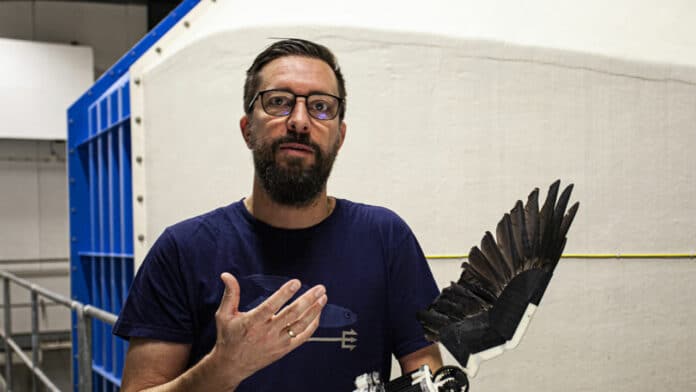The goal of improving drone agility and versatility has directed the attention of many roboticists toward flapping flight, a mode of locomotion used by nature’s active fliers. Among extant flying animals, birds are the largest and arguably the most efficient, making them particularly interesting as inspiration for drones.
However, determining which flapping strategy is best requires aerodynamics studies of various ways of flapping the wings. Therefore, a Swedish-Swiss research team has constructed a robotic wing that can achieve just that – flapping like a bird and beyond. The biohybrid robotic wing is partly built from real feathers, with more advanced kinematic capabilities than previous robotic wings and similar to those of a real bird.
“We have built a robot wing that can flap more like a bird than previous robots but also flap in a way that birds cannot do. By measuring the performance of the wing in our wind tunnel, we have studied how different ways of achieving the wing upstroke affect force and energy in flight”, says Christoffer Johansson, a biology researcher at Lund University.
In their previous studies, researchers have shown that birds flap their wings more horizontally when flying slowly. The new study shows that the birds probably do it, even though it requires more energy because it is easier to create sufficiently large forces to stay aloft and propel themselves. This is something drones can emulate to increase the range of speeds they can fly at.
“The new robotic wing can be used to answer questions about bird flight that would be impossible simply by observing flying birds. Research into the flight ability to live birds is limited to the flapping movement that the bird actually uses”, explains Christoffer Johansson.
In the first case study, the robotic wing is used to systematically study the aerodynamic consequences of different upstroke kinematic strategies at different flight speeds and stroke plane angles. The results indicate that wing folding during upstroke not only favors thrust production, as expected but also reduces force-specific aerodynamic power, indicating a strong selection pressure on protobirds to evolve upstroke wing folding. It is also shown that thrust requirements likely dictate the wing’s stroke tilting.
The team says their results can also be used in other research areas, such as a better understanding of how the migration of birds is affected by climate change and access to food. There are also many potential uses for drones where these insights can be put to good use. One area might be using drones to deliver goods.
“Flapping drones could be used for deliveries, but they would need to be efficient enough and able to lift the extra weight this entails. How the wings move is of great importance for performance, so this is where our research could come in handy”, concludes Christoffer Johansson.
Journal reference:
- Enrico Ajanic, Adrien Paolini, Charles Coster, Dario Floreano, Christoffer Johansson. Robotic Avian Wing Explains Aerodynamic Advantages of Wing Folding and Stroke Tilting in Flapping Flight. Advanced Intelligent Systems, 2022; DOI: 10.1002/aisy.202200148
